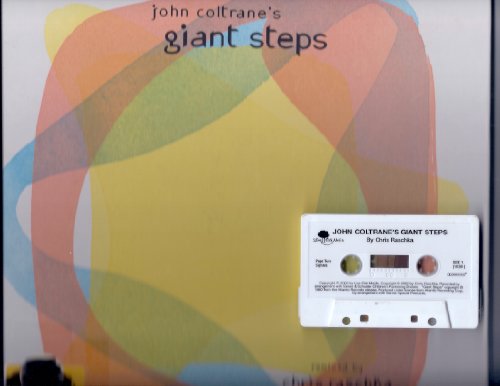Items related to John Coltrane's Giant Steps

"synopsis" may belong to another edition of this title.
As his celebrators will tell you, Raschka has never been guilty of breaking that rule, but in Charlie Parker, he at least took the time to gaze out from his self-created bandstand and observe his audience. It was possible, in this case, for his young readers (or listeners) to enjoy the book even if they couldn't really get with the premise--that, without ever having listened to Parker's landmark version of "A Night in Tunisia," you would be able to "hear" the music by looking at the pictures. Raschka's rendering of Parker's solos into a form of kid-friendly nonsense speak ("Be bop. Fisk, fisk. Lollipop. Boomba, boomba. Bus stop") is likely to prompt a giggle from even that rare youngster whose musical taste runs to "Three Blind Mice." And the delightfully energetic watercolors, whether of Parker himself, blowing mightily into his horn, or of those frisky lollipops swaying across the page, add spectacular color and, yes, a kind of rhythmic bounce to the proceedings. If jazz-loving parents get a kick out of playing "A Night in Tunisia" along with the book (and pretending that their young charges will soon be running the chord changes on their own), what's the harm?
Flush with the success of Charlie Parker Played Be Bop, Raschka moved on to Thelonious Monk, perhaps an even more demanding musician, but by this time his focus was entirely on what was happening on stage, not in the audience. The premise of Mysterious Thelonious goes well beyond the "hear music you've never heard through the pictures" gambit. This time Raschka matches the tones of the chromatic scale to the values of the color wheel (got that?) to produce a visual equivalent of Monk's haunting tune "Mysterioso." Again, the watercolors are charming, squares of color dotting the pages along with oddly hyphenated words jumping up and down to suggest the pianist's heavily syncopated, staccato style. But this time there's no "Boomba boomba bus stop" to engage the "Three Blind Mice" crowd; instead, there's a touchy-feely moral ("There are no wrong notes") sure to make imagination-nurturing adults feel good. Most kids' only chance for entertainment here rides on their jazz-loving parents making funny faces while they explain what the chromatic scale is all about.
And on to John Coltrane, the innovative tenor saxophonist whose harmonic sophistication and "sheets of sound" solos left fellow musicians awestruck. Sure, why not turn "Giant Steps," Coltrane's breakthrough composition, a nearly five-minute sheet of sound played at breakneck pace, into a sequence of watercolors that will teach kids what the innovative tenor sax player was all about? Children's imaginations are limitless, right? Not to mention the fact that Raschka's fans (adults, that is) seem willing to follow their pied piper anywhere, no questions asked.
The premise this time is to build a jazz composition out of shapes (raindrops are the drums, squares the bass, snowflakes the piano, and a big, black cat is the saxophone). The shapes pile on top of one another, spread by spread, theoretically illustrating the idea of harmony, and then the cat pounces--its "giant steps" becoming the melody atop the rhythm section. (And you thought that chromatic scale thing was tricky.) Halfway through the piece, Raschka stops the "band" and chides the performers for doing it wrong. For the first time in any of these three books, there is a two-page spread composed almost entirely of text. Forget "Boomba boomba." Raschka has ascended to the podium. Here are his instructions to the snowflake: "Remember: Coltrane's music is dense but transparent. Okay?" No, not okay. Abstract language used to describe the performing arts rarely communicates much of anything (except perhaps pomposity), but in this case, it is laughably inappropriate. Just try explaining what "dense but transparent" means to the picture-book crowd.
Fortunately, Raschka can draw. His watercolors, suggesting colored tissue paper folded into intriguing shapes, stand on their own, Coltrane aside. The busyness of the drawings has instant kid appeal, but does the jumping cat on the page help you to hear or appreciate John Coltrane? It's pretty to think so, but that's all it is. Why wasn't this book published with a recording of the Coltrane piece, at the very least? Or, even more, why is it a book at all? Here is one case when a video might have worked better than a book. If Raschka's band--cat, snowflake, et al.--were in motion, with Coltrane playing in the background and an experienced, lively music teacher explaining what was happening, then maybe it would be possible to make some tentative connections between jazz, harmony, colors, and shapes.
In the original liner notes to Giant Steps, which was recorded in 1959, Coltrane is quoted by Nat Hentoff as saying, "I'm worried that sometimes what I'm doing sounds like just academic exercises." If only Raschka were similarly concerned. Bill Ott
Copyright © American Library Association. All rights reserved
"About this title" may belong to another edition of this title.
- PublisherLive Oak Media
- Publication date2002
- ISBN 10 0874999731
- ISBN 13 9780874999730
- BindingHardcover
- Rating
(No Available Copies)
Search Books: Create a WantIf you know the book but cannot find it on AbeBooks, we can automatically search for it on your behalf as new inventory is added. If it is added to AbeBooks by one of our member booksellers, we will notify you!
Create a Want
